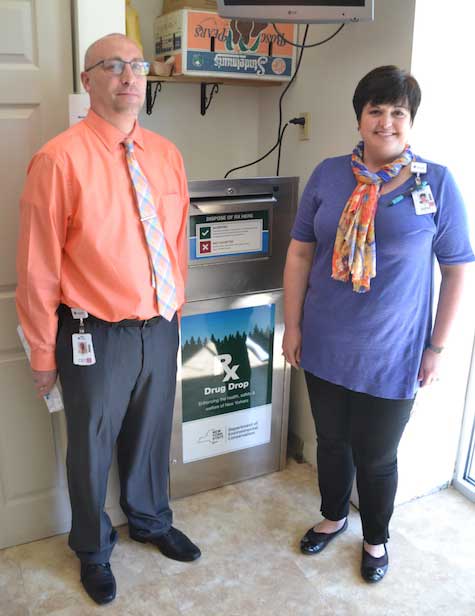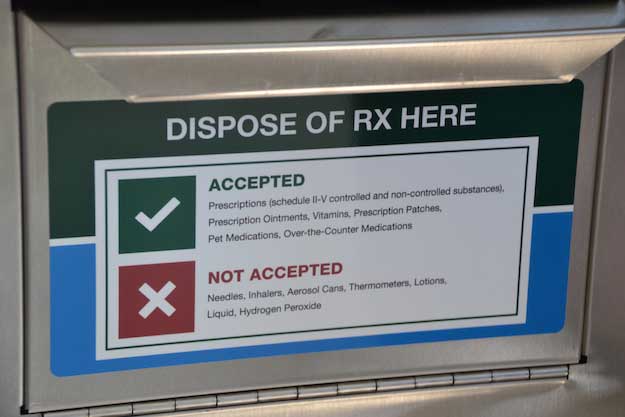Medina hospital, Rosenkrans Pharmacy add drug take-back boxes

Photos by Tom Rivers: A new drug take-box box was added to the lobby of Medina Memorial Hospital last Friday. Mark Cye, chief executive officer for Orleans Community Health and the hospital, is pictured with Kate Brauen, the hospital’s director of pharmacy.
MEDINA – Two new pharmaceutical take-back boxes have been added in Medina with new boxes at Medina Memorial Hospital, 200 Ohio St., and Rosenkrans Pharmacy, 526 Main St.
The State Department of Environmental Conservation in February announced the collection boxes were approved for Medina Memorial and Rosenkrans, which are now among 246 sites to be funded by the DEC for the take-back effort.
“We’re very excited about it,” said Kate Brauen, director of pharmacy for Medina Memorial Hospital. “We think it’s a great community service.”
The DEC paid for the box and packaging materials to send the medication to a service where the pharmaceuticals will be incinerated.
Mark Cye, CEO of the hospital, said the box will help eliminate unneeded prescription drugs from the community.
Rosenkrans received its collection box about two weeks ago. Both Rosenkrans and Medina Memorial have the boxes available while they are open. For the hospital that is all the time, 24-7, because the box is in the lobby for the emergency department.
“Installing medication drop boxes in community pharmacies, hospitals and long-term care facilities, increases opportunities for New Yorkers to properly and easily dispose of unwanted medications,” DEC Commissioner Basil Seggos said in February. “The hundreds of pharmacies and facilities participating in New York’s free drug take-back program are protecting their communities and the environment.”
Under the drug take-back program, DEC will purchase medication collection boxes and pay for the disposal of waste pharmaceuticals collected by participating facilities for two years. Implementation of this pilot program will help improve water quality, protect public health by removing medications from home medicine cabinets, and reduce potential adverse impacts to fish and aquatic organisms, Seggos said.
The statewide Pilot Pharmaceutical Take-Back Program is funded with $2 million from the state’s Environmental Protection Fund.
With technological advances in analytical techniques, it is now possible to detect low levels of drugs in surface water and groundwater. Some drugs pass largely unaltered through wastewater treatment plants and enter rivers and other waterways, the DEC said.
Flushed medications have been found in New York lakes, rivers, and streams and can negatively affect the waterways. A national study conducted in 1999 and 2000, by the U.S. Geological Survey found low levels of drugs such as antibiotics, hormones, contraceptives, and steroids in 80 percent of rivers and streams tested. Medications adversely affect fish and other aquatic wildlife and increase the development of drug-resistant bacteria.
In addition, there are concerns about unused pharmaceuticals getting into the wrong hands. The Centers for Disease Control and Prevention reports that one U.S. citizen dies every 16 minutes from a drug overdose and has declared this public health threat an epidemic.

This shows what is accepted and what isn’t at the collection boxes.





































































